| Label | Label Description | Images |
| Gabriel Pares |
Pares was, for many years at the start of the 20th century, the director
of The Band Of The Garde Republicaine, one of the finest French military
bands of the time. They were first offered for sale in Britian in
December 1912 and were lateral cut 11" sized and it seems trhat
Warroners Ltd were the agents selling these records and they cost 3/6.
It is believed that all the recordings were by the Garde Republicaine,
under Pares' baton. Adverts for the records continued until March 1915
when it was announced that the records would now be labelled "Warroners
Record", though none of this style has been reported to date. Any record sold in Britain at this period would most likely carry Brtish copyright stamps, but I have not seen a Gabriel Pares record with one. It would also be likely that the wording would be in English for the British market as well. |
|
| Gaelfonn |
A Glasgow based record label
from the 1950s, Gaelfonn concentrated on Gaelic (Scottish) material. The
label was founded by Murdo Ferguson, a Gaelic speaker from the Isle of
Lewis. The company address was 102 Maxwell Street, Glasgow C1. My thanks to Richard Prout for providing the label scan. |
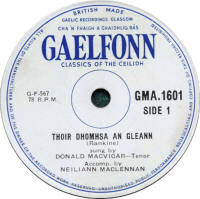 |
|
Gaelic Phono- Grammar |
This was manufactured by Parlophone in the early 1930s. My thanks to Bill Dean-Myatt for providing the label scan. |
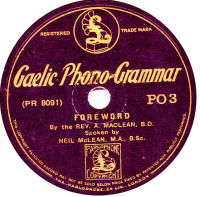 |
| Gael-Linn |
My thanks to Bill Dean-Myatt for providing the label scan. |
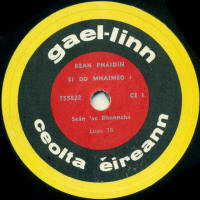 |
| Gaiety |
A very rare label from the WWI period.
The two examples that are known, use masters also available on Jumbo records
of the period. The label of the example shown doesn't even state the
country of manufacture. Frank Andrews reports not seeing them mentioned
in trade journals of the time, and doesn't know for whom they were
produced. My thanks to Norman Field for providing the label scan. |
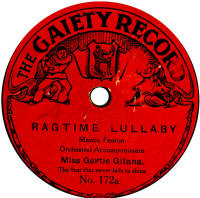 |
|
Gala |
Like the similarly named Gala Goldentone, this was a 6" plastic
children's record dating from the 1960s. I don't know if there is any
link between these two labels, but this one was produced for Selcol (see
label of this name), and the master numbers with a LYN-prefix shows them
to be recorded by Lyntone Ltd. Frank Andrews reports a Gala Recoird Company founded in September 1928 but doesn't know if they ever produced any Gala records. Certainly none have been reported. My thanks to Richard Prout for the image. |
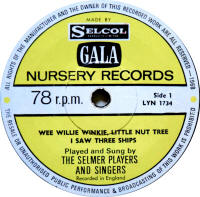 |
| Gala Goldentone | A 6" childrens' record from 1960s. The source material was from America, and presumably would have ben issued on an equivalent childrens' record there. The UK Gala Goldentone records were pressed in orange/red plastic and sold in pictorial sleeves such as the one shown here. They date from the early 1960s and the reverse of the sleeve states that a series of 7" EP records were also available at 2/6, later 3/6. I don't know how much the 6" 78s were sold for. |
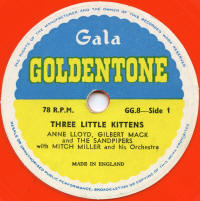 |
| Gallotone |
My thanks to Bill Dean-Myatt for providing the label scan. |
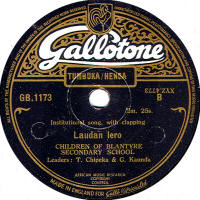 |
| Gamage |
Gamage was produced by The
British Homophone Company for A. W. Gamage Ltd, of Holborn, London. They
are very rare nowadays and little is known about what may be found on
this label, or for how long it was available. They use the same source
of masters as Homochord, i.e. English Vocalion, American Vocalion,
Zonophone and
possibly Emerson, too. The catalogue numbers are in a G-500 series and they don't quite seem to reach G-700. The earlier Green labelled one here, I know nothing about. |
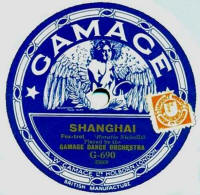 |
| Gaytone |
My thanks to Bill Dean-Myatt for providing the label image. |
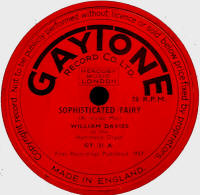 |
| GB |
GB
records were recorded by the Gui De Buire recording company of 83 New
Bond Street, London W1. The company was set up in 1946 by three ex-servicemen and was based in a former builder's yard. The chairman was Guy Whetstone, an ex-squardon leader and radar officer, who had been a recording engineer before the war. His two partners were Andy Whetstone & Bruce Neil. The business manager was ex-naval officer Barry Barron, who had previously worked for Warner Bros & Paramount studios. The company offered a private recording service and many new and established performers made records here. The company charged 25/- for a single-sided 10" record; 2 guineas for double-sided, and £2 10s for a 12" double-sided record. Making demo records was quote costly, but you ended up with a solid example of your work to use to try and get more work. The company also had a mobile recording unit. Many GB records are lacquers (acetates) but proper pressed records were also produced (see example image, right), probably manufactured by another company such as Oriole. The company was dissolved in 1957, and Guy Whetstone subsequelty formed Advision at the same Bond Street address. My thanks to Julian Dyer and Stephen Baird for the company details and to Bill Dean-Myatt for providing the label image. |
_small.jpg) |
| Girmac |
Produced by The Girmac Recordinmg Studio of
111, Union Street, Glasgow. Girmac records may be found both as
direct cut (acetate) discs or as solid stock pressing (like the example
seen here).
My thanks to Bill Dean-Myatt for providing the label image. |
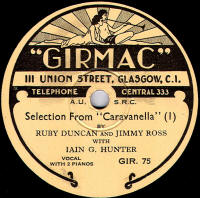 |
| Glenside |
Glenside was a record label recorded and
manufactured in Dublin, (Republic of Ireland), dating from the post
WWII period. The master numbers were allocated by EMI in an OEP-
series. Many, if not all the 78rpnm issues were also issued on
45rpm using the same matrix numbers but with a different prefix.
My thanks to Bill Dean-Myatt for providing the label image. |
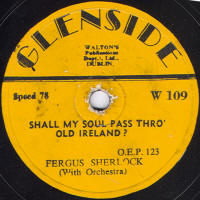 |
|
Globe
(sold in Australia) |
Globe records were
pressed by the Homophon company for sale in Australia during the pre-WWI
years. Masters from both Beka and Favorite were also used. It is
conjectured that these were sold using the tallyman system of selling
direct to customers door-to-door. My thanks to Derek Kell for providing the label scan. |
|
| Globophon |
The Globophon Record company,
which recorded & manufactured these records, was based in Hanover,
Germany from about 1906. Initially they issued the records on the Globos
label (q.v.) but from 1909 they started using the Globophone Record
label. Globophons never had catalogue numbers (i.e. a number common to both sides of the record), the label just showing the matrix number for each side. These were generally in a 3-digit series which the company allocated to instrmental recordings. Other groups of matrix numbers were used for different types od recordings and/or different language recordings. The earliest ones used the design like the first image (right). Some of these had the titling in up to 4 languages, such as this example: German, English, French & Russian. This enabled the company to market them in these countries without having to produce different labels for each country. Those which included the English-language titling, such as this example were marketed & sold in Britain.These mutli-language-labelled records were all (as far as I can tell) instrumental recordings, which meant there were no language issues with selling them internationally. From about 1911, Globophon started recording English-language recordings, usually popular or comic songs. These were given a 6000-series matrix, starting at 6001 and running to over 6300. It is very likely that these were recorded in London. It was cheaper to send over a recording Expert to London, than to get the artists to travel to Hanover! The factor (agent) in England was Frank Rauth, of 9 Christopher Street, Finsbury Square, London, and it was most likely that his premises included recording rooms for Globophon to use. The matrix number on the record usually showed a suffix of KV, which Dr Rainer Lotz suggests would refer to Karl Vogel, who had been a recording expert since 1899 and so was very experienced in the art (or was it a science?) of making recordings. It was probably at this time that the label design changed (see second image) and the ones destined for Britain had the titling all in English. This included any German recordings, which may have previously appeared on the earlier design of label. Globophon records were available in Britain up to the start of WWI in 1914 and cost 1/6, matching the price of other cheap popular records at the time. Even so, they are very scarce. Globophon recordings were also to be found on other German manufactured records sold in Britian. These include Apollo, Eclipse, Festival (which had the same design as Globophon) and Playwell. My thanks to Dr Rainer Lotz & Ray Stephenson for the label photos. |
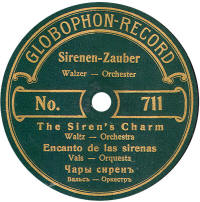 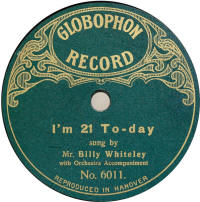 |
| Globos |
Globos records were recorded
and manufactured by the Globophon Company of Hanover, Germany. They were
introduced to the UK in late 1906 and the factor was Frank Rauth at 9,
Christopher Street, Finsbury Square, London. (See advert, right,
courtesy of Frank Andrews, via Norman Field; this is taken from "The
Phono Trader", a trade magazine, of November 1906). A couple of things to note: They are described as "indestructible". Adverts were not regulated in those days, but even so, this is quite extreme. Frank Andrews thought this may just refer to the fact that disc records were much more robust than the rather fragile wax cylinders which were still very popular at this time. They are described as "Cheap". The prices shown are 2/- for single sided & 3/- for double-sided. Considering these are trade prices, and the shop prices would be higher, these are certainly no cheaper than other records of the period. No Globos records have been reported in the UK, so the only images we can show are these (see right), kindly sent to me by Dr. Rainer Lotz. The titling is in German, but the descriptions (e.g. "German Band") are in English, and it may be that this as "English" as Globos records ever got, though I still hold out hope to find one with all-English titling. Given their scarcity, it may be they were only available in the UK very briefly, or maybe the intention was there but they never materialised at all. Presumably Frank Andrews didn't find a listing of titles in the trade magazines of the period as he never produced any listing of the label. By 1909, the Globophon Company had dropped the Globos label and started issuing Globophon Records, q.v. Acknowledgements: Frank Andrews archive, via Norman Field, for the advert. Dr. Rainer Lotz for the label images. If you should find an example with all-English titles, then please e-mail me with details and a scan. |
 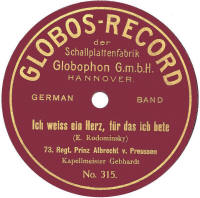 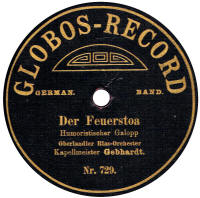 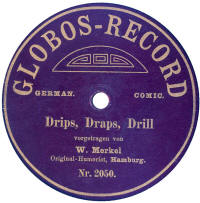 |
| Golden Chords |
These 10" 78rpm records
date to the 1950s and were prodcued by the Christian radio & Television Commission,
and were disctributed by The Victor Press, who had presviously been
involved with Elim Records (q.v.). See also "Silver Tone" records. My thanks to Bill Dean-Myatt for providing the label image. |
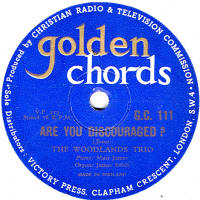 |
| Goodson | One of the more eccentric flexible records available during the late 1920s and early 1930s, Goodson (named after the company's owner, Jack Goodson) were made out of a flexible white material known as Rhodoid. They cost 1/9 (about 9p) and purchasers were encouraged to play them with a used needle! U.S. masters were from Emerson, Grey Gull, Banner & QRS. Own-produced masters were used later on. The vast majority are dance records with the occasional more "serious" item thrown in, sometimes using early continental masters. The sound quality is quite good, but, like most flexibles, they suffer from warping. |
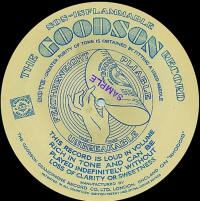 |
| Good Time Jazz |
Dating from the 1940s and 50s, this label
devoted itself to issuing American Jazz, usually of the "Trad" or New
Orleans style, and always contemporary recordings. My thanks to Bill Dean-Myatt for providing the label image. |
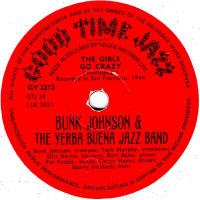 |
| Gospel Melodies |
My thanks to Bill Dean-Myatt for providing the label image. |
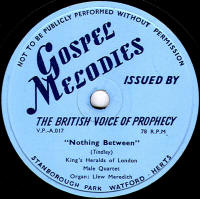 |
| Grafton |
A fairly elusive label, Grafton
records were available from 1924 until 1927, initially with a green
label, changing to red quite soon. It was a product of the Scala Record
Company, denoted in the space for the copyright stamp as SRCo. U.S. matrices were from Emerson &
Federal to start with, but subsequently, all were from Pathe, both
American and English masters. Numbering started at 9001 and may not have
reached 9300 by the time the label was withdrawn. They were 2/- each and thought to be sold in general retail shops. However, a report on the Western Morning News in November 1924 said they were on sale for 2/3, a rather unusual price for a record! My thanks to Hector Hill for the pricing information. |
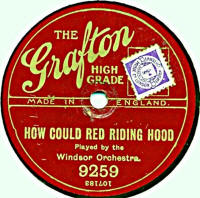 |
| Grammavox |
This was the principal label of the
Sound Recording Company od Swallow Street, Piccadilly, London and the
records were available from 1910 to about 1915. The pressings were done
by Crystalate. The records themselves were oversized at 10¼"
and played at 77 rpm. There were nine catalogue series, usually
depending on the type of material being recorded. Each series was a
letter followed by the number. The letters ran from A to J (without
using 'I') and each
numerical series started at 1. Having said that, it was not unusual for
the label only to show the master number (different on each side, of
course) and no Catalogue number. There were two or three main designs of the label, with other minor changes over time, but the colouring was always a very dark blue background with gold printing. |
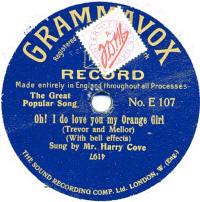 |
| Gramophone |
Although the word
"gramophone" referring to a player of disc records became a
generic term, it was originally the trade name of the Gramophone Company
and the records were therefore Gramophone Records. The "recording
angel" trade mark used by the company in it's Berliner period was
retained from 1902 to 1909, when Nipper and the gramophone appear and
the label name changed in 1910 to "His Master's Voice".
This was as a result of the company trying to copyright the word
"Gramophone", unseccessfully. Gramophone records were available in three sizes: 7" (Gramophone), 10" (Gramophone Concert) and 12" (Gramophone Monarch) and all were single-sided. |
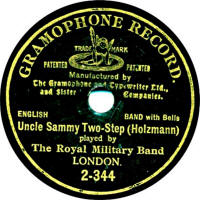 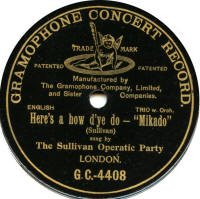 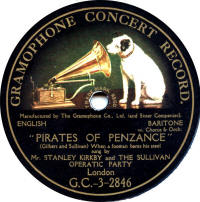 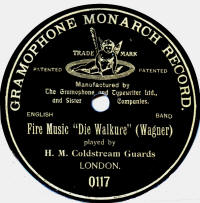 |
| Gramstop |
These were pressed by Crystalate
and sold in 1921, on behalf of The Automatic Gramstop Syndicate
Ltd of Retford, Nottinghamshire. The label design is unusual as it
encompasses a stroboscopic design around the edge, but experiments by
Norman Field show that isn't a stroboscope for modern electrical mains.
It may be suitable for whatever was being used in1921, or may just be a
design which lookds like a strobe! The catalogue series atarted at 100 and the highest reported by Frank Andrews is 123, though No. 1113 has been seen (see below), which just makes the whole things more mysterious! The masters were from The Sound Recording Companies own recordings, also issued on Popular. The only examples I know of are: No. 100; mx 2995; Suzette (waltz) played by the "Burlington" Orchestra (ex-Popular P-1096) No. 100; mx 2998; Sour Grapes (fox trot) (L. Jerome) played by the "Burlington" Orchestra (ex-Popular P-1096) No. 109; mx 2714; Delilah (valse) (H. Nicholls) played by the "Regent" Orchestra (ex-Popular P-994) No. 109; mx 2754; Beautiful Ohio (valse) played by the "Regent" Orchestra (ex-Popular P-964) No. 1113; mx 6004; Berceuse De Jocelyn (Godard) played by D.F. Flynn (cornet) (ex-Popular P-373) Please e-mail me with details of ANY of these records. |
|
|
Grand
Pree
(sold in Australia) |
Grand Pree records were made in England for
export to Australia during the early 1920s. The earlier Grand Pree records are pasted over Winner records (see example 1) and have a rather crude black on red design (not unlike Curry's Westport label). Subsequently, Grand Pree records were made by Pathe, with a properly pressed-on label, using Actuelle masters. There were two styles: a 10" one with 18000-series catalogue numbers and a 12" one with 17500-series catalogue numbers. The third image shown is from one such Pathe-styled issue. All Grand Pree records date from the early to mid 1920s. Thanks to John Culley (via Norman Field), Bill Dean-Myatt and Adam Miller (in order) for providing the label photos. |
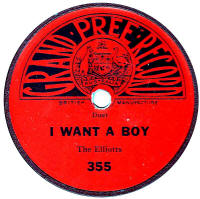 _small.jpg) |
| Great Scott |
Great Scott records was set up by
John Drummond (the 15th Baron Strange) at his home at Megginch Castle,
Perthshire, Scotland in late 1933. Drummond purchased the recording
equipment from Edison Bell Ltd, which was being wound up at the time.
The equipment was of a high quality, having been designed by Edison
Bell's pioneering engineer, P.G.A.H. Voigt. Between 1933 and late 1935,
the company made a number of recordings, both commercial and private ,
mainly of local artists and of Scottish music. Even the commercial
issues were pressed in small quantities and are ver scarce these days. Scan kindly provided by Charles Hippisley-Cox. |
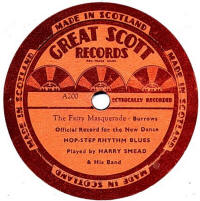 |
| The Greek Dance Association |
This appears to be one of a series made by Decca for this association. Thanks to Richard Prout for the label image |
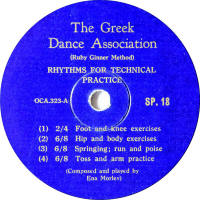 |
| Grey Gull |
A well-known American label whose masters were widely available in
England on labels such as Piccadilly, Goodson & Dominion, but at some
point actual Grey Gull records must have been sold in Britain, as
occasionally they turn up with British Copyright stamps on the labels.
(see example, right). All those I've seen with the UK copyright stanps on are from the latest period, which leads me to believe they were being shipped to the UK at the time that the company went bankrupt in 1930 (or even afterwards - in order to clear the stock of records?). The 1d stamp on the record guides us to a selling price of about 2/6, which is quite expensive and rules out the old hoary myth of them being jobbed off by Woolworths. As to who sold them in the UK? It is still a mystery to me at the present. |
|
| Guardsman |
Guardsman records first appeared
in May 1914. This was a result of a disagreement and a court order
imposed on William Barraud, to stop him using the "Invicta" name for his
records. These first Guardsman
records were manufactured by Crystalate and using Barraud's Invicta master
series which had started at 101 the previous year. The first genuine
Guardsman (as opposed to a re-pressing of an Invicta) was catalogue
number 340 with masters of 245 & 246. The first Guardsman label was either dark mauve or dark blue, but during the war, it seemed they had to use whatever colour was available and they appear also in various shades of red and also in black and later in a pale blue and after the war it became a buff or stone colour. In 1922, Vocalion took over the label, using their own masters and those from Gennett & Vocalion, continued the label until 1928 when they producing ceased 10" contract pressings, by which time the numbers had reached the early 2100s (2140 is the highest known). The likeness of a guardsman on the label was taken from a painting by Francis Barraud (who also painted the famous HMV trademark) of Lieutenant Charles Hassell. In the early Vocalion period there were also a number of masters which were recorded specifically for issue on Guardsman, though some did leak out onto other Vocalion group labels. Also during the Vocalion period there were also a number of other catalogue series catering for ethnic peoples in Britain. These include the well-collected 7000- Negro Jazz series, 6000- and 8000- series Jewish series, a solitary (so far) 6750 Polish, a couple of Welsh series of 7250- and N-8250 and probably others which have not been located as yet. 12" Guardsman records were available throughout the whole period, with a catalogue series starting at 2000 and running up to 2136 (the highest found so far) from the Crystalate era (up to 1920), and there was also a 12" series made by Vocalion in the early 1920s with a 500-series catalogue. Who said record collecting was simple ? Guardsman recordings from the Barraud/Crystalate period may also be found on the early yellow "Curry's" label sold by the famous bicycle manufacturer, and also on Citizen, Neptune and Melody Record labels. |
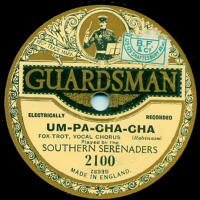 |